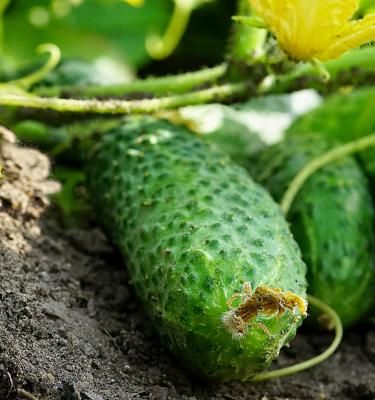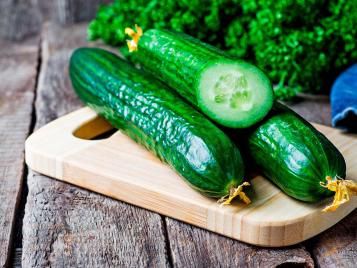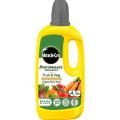

How to grow cucumbers
Delicious in salads and sandwiches, the crisp, sweet crunch of a cucumber is one of the joys of summer. Growing cucumbers takes a little care and attention, but the results are well worth the effort. To learn how to grow cucumbers, follow our essential guide. Soon your summer salads will be sweet, delicious and super-satisfying.
Choosing the best cucumbers to grow
Cucumbers are divided into indoor- and outdoor-grown varieties, so growing cucumbers starts with choosing which type of cucumber you want.
Indoor-grown cucumbers are usually long, with smooth skins, and need to be grown in greenhouses to protect them from the changing weather. Outdoor-grown cucumbers are hardier and often shorter with ridged or bumpy skins. They need less care than indoor varieties, so they’re a good choice for a first time grower.
Here are a few cucumber varieties to look out for…
Indoor cucumbers
- Cucumber ‘Emilie’ AGM
- Cucumber ‘Femdan’ AGM
- Cucumber ‘Carmen’ AGM
Outdoor cucumbers
- Cucumber ‘Marketmore’ AGM
- Cucumber ‘Burpless Tasty Green’
What you’ll need to start growing cucumbers
To begin your cucumber-growing journey, you will need:
- 9cm pots for sowing seeds
- Dibber
- Multipurpose compost such as Miracle-Gro Premium All Purpose Compost
- Long canes or other supports
- Spade
- 25-30cm diameter pots for indoor-grown cucumbers
- Compost or farmyard manure for outdoor cucumbers

When to sow your cucumber seeds
- When to sow cucumbers depends on whether you are growing indoor or outdoor varieties, and also on where you plan to grow them.
- In heated greenhouses, sow indoor cucumbers from late winter to early spring.
- If your greenhouse is unheated, wait until mid-spring before sowing indoor cucumbers.
- Start outdoor cucumbers off indoors by sowing in pots in late spring.
- Outdoor cucumbers can be also sown outside directly into the soil in early summer. They need a sheltered, sunny spot in good soil.
How to grow cucumbers from seed
- Fill 9cm pots with multipurpose compost.
- Using the dibber (or a pencil), make a hole 2.5cm (1in) deep in the centre of the compost.
- Sow one seed per pot, placing it in the hole on edge rather than flat. This reduces the risk of the seeds rotting.
- Cover with compost, and water well.
- When sowing cucumber seeds directly outdoors, sow them 2.5cm (1in) deep, as for pots, and cover the young seedlings with cloches or horticultural fleece to give them protection in cool weather.
How and when to plant your cucumbers?
Once the seedlings are big enough to handle (usually around 3-4 weeks after germination), transplant indoor cucumbers into individual 25-30cm diameter pots filled with multipurpose compost. Place a long cane in each pot to support the plant as it grows.
Outdoor cucumbers that have been sown indoors in spring can be planted outside in early summer. Harden the seedlings off for a week first by placing them outside in their pots during the day and bringing them back inside at night.
Before planting cucumbers outdoors, prepare the soil by digging in compost or well-rotted farmyard manure, then scatter a general-purpose fertiliser at 100g/m2 over the soil and rake it in.
Plant outdoor cucumber seedlings 90cm (3ft) apart and water well. You don’t need to provide supports for them unless you are trying to save space – they will grow happily sprawling across the ground.
How to care for your cucumbers?
The key to growing cucumbers is not to stress the plants while they are growing, as this will make the fruits taste bitter. Follow these tips for the best harvest:
- Water regularly, keeping the soil or compost moist but not waterlogged.
- To reduce the risk of fungal disease, avoid watering the leaves of the plants.
- Once flowers appear, feed the plants fortnightly with a balanced liquid feed.
- Train greenhouse cucumbers up canes or other supports to increase yield.
- Pinch out plants (remove the new leaves at the tips of growing shoots), to encourage the plants to put all their energy into producing fruit rather than foliage. Pinch out the growing tips on the main stems of greenhouse cucumbers once they reach the greenhouse roof. Make sure that you pinch out the tips of outdoor plants earlier, once the main stem has produced seven leaves.
- Pinch out any flowerless side shoots once they reach 60cm (2ft) long (for indoor cucumbers) or have produced seven leaves (outdoor cucumbers).
- Remove male flowers from indoor cucumbers to prevent pollination (see below).
How to pollinate cucumbers
When it comes to pollination, cucumbers have a few quirks. One of these quirks is that they produce separate male and female flowers.
It’s easy to tell the male flowers from the females, as the male flowers are on thin stems, while the stems of female flowers look like tiny cucumbers (which is what they will develop into).
Some cucumber plants have been bred to produce only female flowers, and these are called all-female plants. Other cucumbers produce both male and female flowers on the same plant.
Most indoor cucumber varieties are all-female and can develop fruits without needing to be pollinated. In fact, if they are pollinated, the cucumbers will taste bitter, so if any male flowers do appear on greenhouse cucumbers, remove them immediately to prevent pollination.
Outdoor cucumbers produce both male and female flowers on the same plant. They need to be pollinated in order to produce fruit, so don’t remove any flowers from outdoor plants, just let the pollinating insects do their thing.
When to harvest your cucumbers
Harvest cucumbers any time between July and October once the fruits are between 15-20 cm (6-10in) long. Use a sharp knife to cut cucumbers off the plant. Pick frequently to encourage the plant to produce more cucumbers.
It’s time to give cucumber-growing a go. Once you’ve tasted your own cucumbers fresh from the plant, you’ll never look back.
Common pest or disease problems with cucumbers
Powdery mildew
Powdery mildew is a common cucumber disease. This is a fungal disease that appears as a white powdery deposit on cucumber leaves, stunting growth and causing leaves to shrivel. Drought-stressed plants are more susceptible to this disease.
- Dig organic material into the soil before planting to improve soil water retention
- Space plants when planting to ensure good air circulation
- Remove any affected growth promptly
- Water regularly in dry periods
Cucumber mosaic virus
Cucumber mosaic virus can cause yellow leaves on cucumber plants, with a characteristic ‘mosaic’ patterning. Affected plants produce few or no flowers, and any cucumbers that develop are small and inedible.
- Remove and destroy affected plants promptly
- Wash hands and tools after handling affected plants
- Plant disease-resistant varieties
- No chemical controls are available
Cucumber plants wilting
If cucumber plants start to wilt suddenly despite normal watering, this may be due to sudden changes in temperature, or draughts caused by opening greenhouse vents or doors.
- Don’t water wilted plants unless the soil is dry as this could cause root rot
- Keep greenhouse temperature and humidity levels as constant as possible
- Plants may recover if quickly moved out of draughts
Glasshouse red spider mite
Glasshouse red spider mite is a sap-sucking mite that can affect greenhouse-grown cucumbers. Severe infestations cause plants to drop leaves and eventually die. Symptoms include a fine webbing covering leaves and stems, and mottled leaves with tiny mites and eggs on their undersides.
- Ensure good ventilation in greenhouses
- Mist plants to raise the humidity levels, or damp down greenhouse floors
- A predatory mite can be used as a biological control
- Use pesticide sprays suitable for use on edible plants
Glasshouse whitefly
Glasshouse whitefly suck plant sap and excrete a sticky substance called ‘honeydew’ which covers cucumber leaves and encourages the growth of sooty mould, stunting plant growth. They can also transmit viruses.
- A parasitoid wasp can be used as a biological control
- Keep gardens clear of weeds which can harbour whitefly
- Use pesticide sprays suitable for use on edible plants
Key features of cucumbers
| Flowering season(s) | Summer |
|---|---|
| Foliage season(s) | Spring, Summer, Autumn |
| Sunlight | Full sun |
| Soil type | Loamy |
| Soil pH | Neutral to slightly alkaline |
| Soil moisture | Moist but well-drained |
| Ultimate height | 30cm (12in) |
| Ultimate spread | 30cm (12in) |
| Time to ultimate height | 3-4 months |




